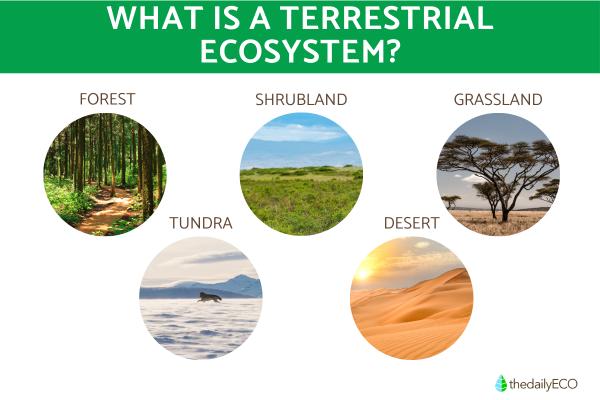
Have you ever wondered why some places on Earth are covered in dense forests while others are barren deserts? Or why certain animals and plants can only be found in specific locations? The answer lies in the fascinating world of terrestrial ecosystem. Terrestrial ecosystems are all around us, from the trees in your backyard to the wide-open plains of the Midwest.
In this article by thedailyECO, we’ll break down what a terrestrial ecosystem is, how it works, and why it’s so important to life on Earth
What are terrestrial ecosystems?
Terrestrial ecosystems are biological environments that exist on land masses across the globe. Unlike aquatic ecosystems, these environments support organisms that develop primarily on or below the soil surface, including those that inhabit the air above.
These dynamic systems comprise both living (biotic) and non-living (abiotic) components that interact in complex ways.
These ecosystems harbor tremendous biological diversity due to the wide range of environmental conditions that shape them. From lush tropical rainforests to stark desert landscapes, terrestrial ecosystems represent some of Earth's most productive and ecologically significant habitats.
The defining feature of all terrestrial ecosystems is their land-based nature, though they vary dramatically in climate, soil composition, vegetation structure, and biodiversity levels. Each ecosystem type hosts specialized flora and fauna adapted to thrive under specific environmental conditions.
Terrestrial ecosystems cover approximately 29% of Earth's surface, but contain over 80% of all plant and animal species.
Curious about life beneath the waves? Explore how underwater ecosystems compare to their land-based counterparts in our comprehensive guide to water-based ecological communities.

What are the characteristics of a terrestrial ecosystem?
Understanding the fundamental properties of land-based ecosystems helps explain their tremendous diversity and ecological functions. Here are the six primary characteristics that define and differentiate terrestrial ecosystems:
1. Variable climate conditions:
Climate represents perhaps the most influential factor shaping terrestrial ecosystems. Temperature patterns, precipitation levels, sunlight exposure, and wind conditions vary significantly across different regions and elevations, creating distinct environmental niches.
These climatic variables determine which organisms can survive in a particular location. For example, tropical rainforests thrive under consistent warmth and abundant rainfall, while desert ecosystems have adapted to extreme heat and minimal precipitation.
Climate also influences seasonal cycles, affecting everything from plant flowering periods to animal migration patterns within terrestrial ecosystems.
2. Soil composition and structure:
Soil serves as the foundation of terrestrial ecosystems, providing essential nutrients, water, and physical support for plant life. The chemical and physical properties of soil vary dramatically between ecosystem types and significantly impact vegetation patterns.
Key soil properties include texture (proportion of sand, silt, and clay), pH level (acidity/alkalinity), organic matter content, nutrient availability, and water retention capacity. For instance, rainforest soils often feature rapid nutrient cycling but poor long-term nutrient retention, while grassland soils typically contain higher organic matter content that supports productive plant growth.
3. Resource distribution patterns:
The availability and distribution of critical resources, such as water, sunlight, and nutrients, create ecological gradients that influence biodiversity patterns across terrestrial ecosystems.
Water availability represents a particularly crucial factor, with ecosystem productivity generally increasing alongside precipitation levels. This relationship explains why rainforests support extraordinary biodiversity compared to arid ecosystems like deserts.
4. Topographic and geographic factors:
Physical landscape features significantly influence terrestrial ecosystem development and diversity. Elevation changes create temperature and precipitation gradients. Latitude affects seasonal patterns and solar radiation intensity. Landforms like mountains and valleys create diverse microclimates. Aspect (direction a slope faces) impacts sunlight exposure and moisture levels.
These topographic factors help explain why mountain ranges often host multiple ecosystem types arranged in elevational bands, each supporting distinct plant and animal communities.
5. Rich biodiversity adaptations:
Terrestrial ecosystems host remarkably diverse flora and fauna with specialized adaptations to their environments. These adaptations demonstrate evolution's response to the specific challenges of each ecosystem type.
The morphological diversity of terrestrial organisms reflects millions of years of adaptation to the specific conditions of their ecosystems. Vertebrates (mammals, birds, reptiles, amphibians) and invertebrates (insects, arachnids, mollusks) have each evolved distinct solutions to the challenges of terrestrial living.
6. Complex ecological interactions:
The intricate relationships between organisms form the foundation of terrestrial ecosystem functioning. These ecological interactions include food webs, mutualistic relationships, competition, predator-prey dynamics, and symbiotic associations. These biological interactions create resilient networks that help maintain ecosystem stability.
5 Types of terrestrial ecosystems
Terrestrial ecosystems are typically classified into five major categories based on their predominant vegetation structure and climatic conditions. Each type hosts distinctive plant and animal communities adapted to specific environmental conditions.
1. Forest ecosystems:
Forests represent the most biologically diverse terrestrial ecosystems, characterized by abundant tree coverage that creates multiple vertical habitat layers. These ecosystems serve as crucial carbon sinks, wildlife habitats, and sources of countless ecological services.
Forest types include:
- Tropical rainforests: Located near the equator with high rainfall, warm temperatures, and extraordinary biodiversity.
- Temperate deciduous forests: Found in mid-latitude regions with distinct seasons and broad-leaved trees that shed annually.
- Coniferous forests: Dominated by evergreen, needle-leaved trees adapted to cooler climates and often nutrient-poor soils.
- Mediterranean forests: Featuring drought-resistant trees and shrubs adapted to hot, dry summers and mild, wet winters.
- Tropical dry forests: Experiencing seasonal rainfall patterns with adaptations for extended dry periods.
Forests typically feature complex canopy structures that create distinctive microhabitats, supporting specialized organisms at each vertical level from the forest floor to the uppermost canopy.
2. Shrubland ecosystems:
Shrubland ecosystems are dominated by woody vegetation shorter than trees but taller than herbaceous plants. These ecosystems often develop in transitional zones between forests and grasslands, or in regions where environmental conditions limit tree growth.
Shrublands typically feature plants with adaptations to periodic drought, fire disturbance, or grazing pressure. Many shrubland species have developed specialized reproductive strategies tied to these disturbance regimes.
3. Grassland ecosystems:
Grassland ecosystems are dominated by grasses and herbaceous plants with few trees. These ecosystems develop in regions with moderate precipitation levels—sufficient to prevent desert formation but insufficient to support forests.
Major grassland types include:
- Temperate grasslands: Including prairies, steppes, and pampas in mid-latitude regions.
- Tropical savannas: Featuring scattered trees among extensive grass coverage in warm regions with seasonal rainfall.
- Montane grasslands: High-elevation systems with specialized cold-adapted grasses.
- Flooded grasslands: Periodically inundated areas supporting specialized vegetation.
Grassland ecosystems have traditionally supported vast herds of grazing mammals along with their associated predators. The deep, fibrous root systems of grassland plants create some of the world's most fertile soils.

4. Tundra ecosystems:
Tundra ecosystems represent Earth's coldest terrestrial environments where tree growth is impossible due to low temperatures, strong winds, and often permanently frozen subsoil (permafrost).
Tundra variations include:
- Arctic tundra: circling the North Pole with extremely cold winters and brief summers.
- Alpine tundra: found at high elevations worldwide above the tree line.
- Antarctic tundra: limited to ice-free areas of Antarctica and nearby islands.
Despite harsh conditions, tundra ecosystems support specialized plant communities (primarily mosses, lichens, dwarf shrubs, and grasses) and animals adapted to extreme cold. Many tundra species have developed remarkable cold-tolerance mechanisms and efficient energy utilization.
5. Desert ecosystems:
Desert ecosystems develop in regions receiving less than 10 inches (25 cm) of precipitation annually. These arid environments create some of Earth's most challenging conditions for life, yet host remarkably adapted organisms.
Desert categories include:
- Hot deserts: like the Sahara, featuring extreme heat and minimal rainfall.
- Cold deserts: such as the Gobi, with freezing winters and hot summers.
- Coastal deserts: influenced by ocean currents that limit precipitation.
- Polar deserts: including parts of Antarctica, combining extreme cold and minimal moisture.
Desert organisms display fascinating adaptations to water scarcity, including succulent water storage tissues in plants like cacti, nocturnal activity patterns in many animals, specialized water conservation mechanisms, and extended dormancy during unfavorable conditions.
While deserts typically have lower overall biodiversity than other terrestrial ecosystems, they often feature high levels of endemism, species found nowhere else on Earth.
Did you know that small everyday actions can have significant impacts on preserving Earth's diverse ecosystems? Explore effective conservation techniques in our related guide to environmental protection.
If you want to read similar articles to What Is a Terrestrial Ecosystem?, we recommend you visit our Ecosystems category.
- National Geographic Society. (2023). Terrestrial ecosystem. National Geographic Education. https://education.nationalgeographic.org/resource/terrestrial-ecosystem/
- Qin, Y., Xiao, X., Wigneron, J. P., Ciais, P., Canadell, J. G., Li, X., Crowell, S., Zhang, X., Lei, L., Xu, S., Wang, M., Asrar, G. R., Jin, C., Liang, S., Wang, T., Chen, H., Kim, Y., & Moore, B. (2021). Carbon losses from terrestrial ecosystems to inland waters globally. Nature, 597(7876), 391–395. https://www.nature.com/articles/s41586-021-03939-9